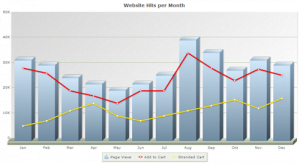 Summary: Every day, businesses suffer from the effects of bad or outdated Business Intelligence. These outdated BI tools/practices waste precious time, harm decision-making, and keep these companies from truly taking advantage of their data. Fortunately, bad BI tools/processes display many warning signs. These warning signs will help alert you to a problem, and keep that problem from spiraling out of control. Do you notice any of these warning signs in your business?
Summary: Every day, businesses suffer from the effects of bad or outdated Business Intelligence. These outdated BI tools/practices waste precious time, harm decision-making, and keep these companies from truly taking advantage of their data. Fortunately, bad BI tools/processes display many warning signs. These warning signs will help alert you to a problem, and keep that problem from spiraling out of control. Do you notice any of these warning signs in your business?

If you own a car, it has most likely given you a warning sign at one point or another. Maybe it displayed a warning light on your dashboard. Maybe it began idling roughly. Or, maybe the brakes started squeaking one day.
When these warning signs appear, what do you do? Do you ignore them and hope they go away? Or, do you take it to the mechanic and get it fixed? Of course, you get it fixed (I hope). Ignoring those warning signs will eventually leave you stranded by the side of the road.
I bring up this analogy because it applies nicely to Business Intelligence (BI). Around the world, many companies use Business Intelligence that needs replacing. In some cases, faulty BI processes slow them down. In other cases, outdated BI tools waste time and keep them from capitalizing on their data.
The good news: Just like a car, outdated BI displays warning signs. If you pay attention, these warning signs can save you from larger problems down the road.
The problem: Many companies don’t recognize these signs.
What are the warning signs of bad BI? Today, let’s answer that question. Here are a few warning signs that you need better Business Intelligence:
1. Creating reports is time consuming
We live in an increasingly data-driven world. Your ability to turn your data into meaningful management information plays a larger role on your business than ever before.
The question: How long does this process take? As explained below, if the answer is anything more than “minutes or hours”, there’s a problem.
“Probably the biggest warning sign is based on the amount of time being spent “manually” preparing reports or charts,” says Dr Alan McCabe, Deputy Chief Operating Officer at Software Group. “If it’s time consuming or labor intensive to get the information you need (for example, if someone spends the best part of a week at the end of each month preparing reports, consolidating multiple spreadsheets, different data sources etc.), then this is a big fat warning sign.”
2. Reporting runs through a single department

A similar problem that we see far too often: Reporting runs through a single department (usually the IT department). In the past, this process made sense. After all, creating reports required a fair amount of technical skill. Users couldn’t do this on their own.
These days, that’s no longer the case. With the availability of end-user reporting options, there’s really no need for a single department to handle reporting. However, this still happens in many businesses–a problem that wastes time for all involved.
“If users still submit reporting requests to a single department, that’s a warning sign of bad BI,” says Rick Hurckes, Services Director at mrc. “When reporting goes through one department, it creates a bottleneck that wastes everyone’s time. The users wait days for their reports, and the report creator gets overwhelmed with reporting and report customization requests. A modern BI solution should deliver self-service capabilities to the end users.”
3. People have stopped asking for more/different information
One huge advantage offered by a good BI solution: It promotes questions. Because data is so easily analyzed, users begin asking (and answering) new questions about the business. These types of activities lead to a data-driven culture, where employees use data to improve the business.
The opposite is also true. If users have no easy way to analyze data, the conversation changes. How so? As explained below, the conversation revolves around BI complaints rather than data.
“If most of the conversations about BI are about how expensive and slow it is, or how unresponsive IT is, and nobody is asking for new questions to be answered, you are in trouble,” explains Gene Connolly, President/Principal Consultant at Connolly Consultants LLC.
4. You have no way to easily visualize data
 Let me ask you a question. What is easier to understand: A table full of data or a graph? Which one communicates the data faster?
Let me ask you a question. What is easier to understand: A table full of data or a graph? Which one communicates the data faster?
Of course, the graph does. Data visualizations not only make it easier to understand data, they help you see things that aren’t obvious when looking at rows and rows of data.
The big question: How easily can you visualize data using your current BI methods? If creating data visualizations is a big deal, that’s a warning sign.
“Looking through spreadsheets, tables or “walls” of numbers comes naturally to some people, but for the vast majority it’s very difficult to identify trends or issues from a page full of numbers,” says McCabe. “Visualisation tools such as simple charts, dashboards, gauges or maps make it possible to identify trouble spots, potential issues or worrying trends instantly, and ultimately make your BI practices vastly more effective and efficient.”
5. You have no built-in drill-down and drill-up capabilities
Your BI solution must let you explore your data as needed. It starts you off with a high level view of your data, and lets you drill deeper to the most minute details.
Why is this so important? Without this capability, your BI doesn’t offer much value. It will give you the “what”, but not the “why.”
“In a scenario where your BI tools allow to you identify a problem (for example a region where your staff performance is abnormally low), users should be able to immediately “drill down” and look at the details that contribute to that region (e.g. is this poor regional performance just due to one or two poorly performing staff who could be re-trained or moved on?),” explains McCabe. “If users are unable to drill down and instead have to access another report, or worse, another system, then the odds of them doing so and quickly implementing solutions drop dramatically.”
6. You can’t identify who “owns” BI
It’s a common problem: Many people get involved during the implementation phase of a BI solution. But, after it’s rolled out, no one owns it. Everyone thinks another department is in charge, and the BI solution stagnates.
The problem: Without clear ownership, BI will never succeed. This doesn’t necessarily mean you need a new tool. Rather, it’s a call for a better BI process. If you want to get the most out of your BI solution, you need a clear “owner” who will ensure that it succeeds.
“IT put it in because they thought they should, but doesn’t have a business strategy for BI,” says Connolly. “No one outside of IT has a BI strategy, and thinks IT should. You built it, but they didn’t come. Time to reboot and get the basics in place regarding accountability and a strategy to generate measurable business value with a BI investment.”
Summary
Now, these are just a few warning signs of bad BI tools/processes, but the list could go on. If you would like to add anything to this list, I’d love to hear it. Feel free to share in the comments.